
- Usage in publication:
-
- Raspberry formation*
- Modifications:
-
- Original reference
- Dominant lithology:
-
- Slate
- AAPG geologic province:
-
- Great Basin province
Summary:
Raspberry formation. Gray, black, buff, or green slate, locally phyllitic; limestone lenses and limestone conglomerate, especially in lower part; quartzite lenses a few inches to 100 feet in thickness form about 5 percent of unit. Thickness in East Range approximately 3,000 feet; top and base not visible. In fault contact with older formations. Lithologies similar to Winnemucca formation. Fossils. Bivalve (MONOTIS SUBCIRCULARIS) from lower part of formation, identified by S.W. Muller, indicate Norian age. Age is considered Late Triassic (Norian).
Type locality: Raspberry Creek, northwestern part of East Range, north-central NV.
Source: Publication; US geologic names lexicon (USGS Bull. 1200, p. 3202).

- Usage in publication:
-
- Raspberry Formation*
- Modifications:
-
- Revised
- Principal reference
- Dominant lithology:
-
- Slate
- Sandstone
- Limestone
- AAPG geologic province:
-
- Great Basin province
Summary:
Pg. E3 (table 1), E6 (fig. 3), E8, E9. Raspberry Formation of Auld Lang Syne Group. Raspberry Formation of Ferguson and others, 1951 (USGS Geol. Quad. Map GQ-11, 1 sheet, scale 1:125,000) included in Auld Lang Syne Group (new). Chiefly argillaceous rocks but has subordinate amounts of limestone in its lower part. Intercalations of sandstone form only a minor part of the formation. Estimated thickness 3,000 feet; base and top not exposed. Farther north in Krum Hills [Humboldt County, McDermitt quadrangle, scale 1:100,000] strata assigned to the Raspberry by Willden, 1964 (Nevada Bur. Mines Bull., no. 59, 154 p.) is believed to be about 7,000 or 8,000 feet thick. [The Raspberry of Krum Hills is shown (fig. 3) to be equivalent to Compton's (GSA Bull., v. 71, no. 9, p. 1383-1416, 1960) Singas, Adorno, and lower part of Mullinix Formations (Norian to Rhaetian) of southern Tobin Range, Pershing County, herein also included in Auld Lang Syne Group.] Is younger than, and lithologically similar to, Winnemucca Formation of Auld Lang Syne Group; the Raspberry is faulted against the Winnemucca in East Range and Krum Hills. Fossils. Ammonoids from unknown stratigraphic position in type Raspberry represent HIMAVATITES COLUMBIANUS Zone of late middle Norian age, and late Norian bivalve MONOTIS SUBCIRCULARIS occurs in rocks assigned to the Raspberry by Ferguson and others (1951) in Krum Hills. Age is Late Triassic (middle Norian to Rhaetian).
"…to bring the definitions of the formations of the Auld Lang into closer accord with the modern rules of stratigraphic nomenclature [ACSN, 1970], the original 'type localities' … are here redesignated as type areas. New type localities which are geographically more restricted than the old type areas are defined in table 1 [p. E3]…"
Type locality: along Raspberry Creek, in secs. 31 through 33, T. 34 N., R. 36 E., Rose Creek 15-min quadrangle, Pershing Co., northwest East Range, north-central NV.
Type area: Raspberry Creek, northwestern part of East Range, north-central NV (Ferguson and others, 1951).
Source: Publication; GNU records (USGS DDS-6; Menlo GNULEX).
For more information, please contact Nancy Stamm, Geologic Names Committee Secretary.
Asterisk (*) indicates published by U.S. Geological Survey authors.
"No current usage" (†) implies that a name has been abandoned or has fallen into disuse. Former usage and, if known, replacement name given in parentheses ( ).
Slash (/) indicates name conflicts with nomenclatural guidelines (CSN, 1933; ACSN, 1961, 1970; NACSN, 1983, 2005, 2021). May be explained within brackets ([ ]).

